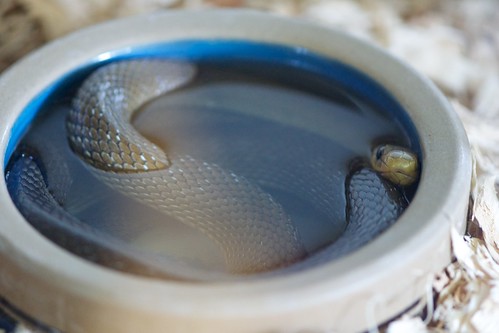Too hot for snakes
This week has been hot and oppressive, and today’s heavy rain is a welcome respite. Not just for us, but for our snakes. For the past week, we’ve been keeping an eye on the thermometers and the snakes’ behaviour to ensure that they aren’t overheating. We don’t have air conditioning, so it’s gotten as warm as 34°C in our house. At that point the snakes start taking to their water dishes, hoping to cool off. Every so often we mist the cages down with refrigerated water. If it had gotten any warmer, I would have started dropping ice cubes in their water dishes — whether or not they were still soaking in them — because at that point I’d be worried about having some of them die on me.
You may be surprised to learn that hot weather isn’t always good for cold-blooded animals. It is actually possible for a reptile to get too warm. In fact, it’s far easier to kill a reptile with heat than it is with cold. A cold reptile stops eating or simply hibernates; it would take freezing temperatures to be fatal. But it’s embarrassingly easy to kill a captive reptile with heat: a glass cage in direct sunlight is all it takes.
According to What’s Wrong with My Snake? by John and Roxanne Rossi (Amazon.ca, Amazon.com), the amateur guide to snake care, a seriously overheated snake will thrash around its cage with its mouth agape. The treatment is to immerse the snake in cool running water to get its body temperature under control. (The Rossis identify several nasty scenarios that are far worse than a heat wave, such as sunlight hitting a cage, heating pads at too high a setting, or transporting an animal in a hot car.)
Remember that “cold-blooded” is imprecise: reptiles are ectotherms (more specifically poikilotherms), which means they control their body temperatures through external means. If they cannot escape the heat, they simply have no means of cooling down. They can’t pant; they can’t sweat. All they can do is move to a cooler area, and if they can’t do that because they’re trapped in a hot cage, they’re toast.
A number of snakes don’t even need particularly warm temperatures, particularly if they come from montane or cold habitats. Species as diverse as Rubber Boas, Eastern Fox Snakes and Leopard Snakes can do very poorly if they’re kept at temperatures above 25°C; I’ve heard that such temperatures can even be fatal for Mandarin Rat Snakes.
Lizards, as a group, do better at hot temperatures than snakes do — or rather there are a lot more lizards that thrive at 40°C than there are snakes, and there are a lot more snakes that can tolerate single-digit temperatures than there are lizards — it’s one reason why, for example, the reptiles found furthest north are snakes, and why Canada has fewer lizards than snakes.
Because we work exclusively with colubrids, almost all of which come from North America, we simply don’t have to heat them very much. During the summer, we don’t have to heat them at all — it’s more than warm enough here for corn, rat, pine and garter snakes. Instead, when the heat wave strikes and the temperatures climb into the mid-thirties, we stock the freezer with ice cubes and the fridge with misting bottles, and watch out for overheated snakes.
The temperature in the snake room is now 28°C, so the worst, I think, is now behind us.
